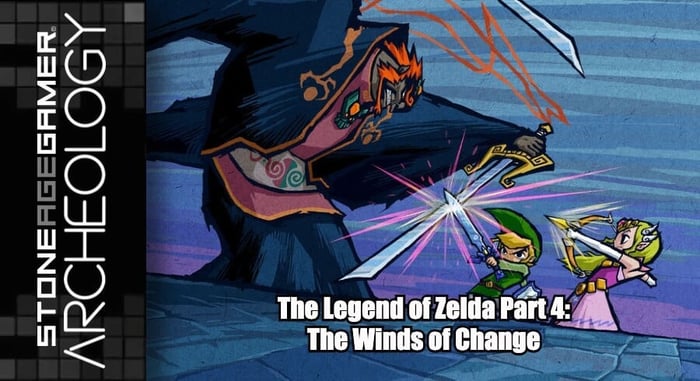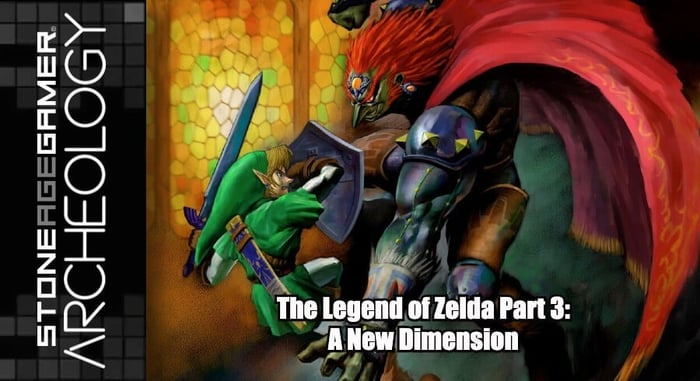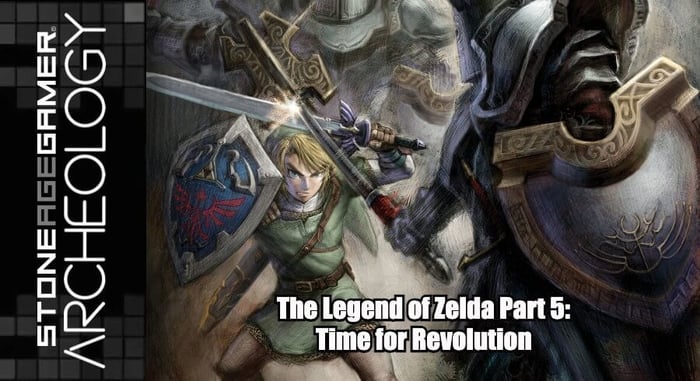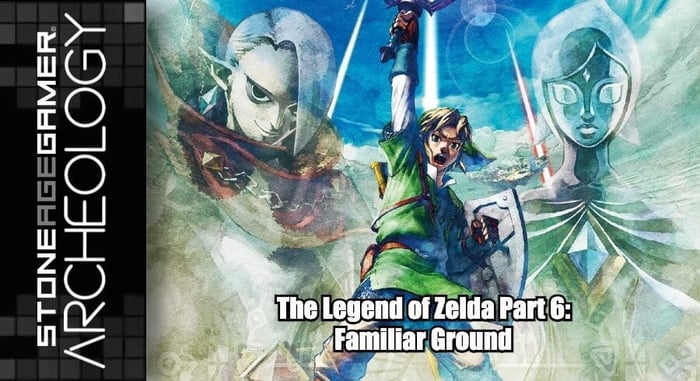
The Legend of Zelda Retrospective Part 4 - The Winds of Change
Welcome to Part 4 of our 8-part Zelda retrospective. In this series, we aim to tell the story of the Zelda series as it unfolded for North American audiences. We are not only looking at the games themselves, but the historical context surrounding them, and what it was like being a fan as these games were being released.
In this episode, we cover Nintendo's controversial decision to change Zelda's visual design from semi-realistic to cartoon, and the volatile fan reaction to the alteration. Plus, Zelda goes multiplayer, and Capcom creates their swan song.
Watch more Stone Age Gamer Archeology: https://youtube.com/playlist?list=PLoWJAVdwC7Z_CC...
Transcript of the video:
Video games were once again changing, and Nintendo was quickly being left behind. On the home console front, the Nintendo 64 had been struggling, especially in terms of what it had done to Nintendo’s reputation. While the reality of their philosophy has always been that their games are for everyone, the public perception at the time had become that Nintendo games were for children. But following their Spaceworld 2000 presentation, fans felt confident that the GameCube was going to be different, and Zelda was going to deliver on the next generation experience they had hoped for.
As Spaceworld 2001 approached, anticipation for a closer look at Zelda for GameCube had reached a fever pitch. But when Nintendo finally unveiled Link’s next generation adventure, nobody could believe their eyes.
The audience applauded politely, but it was clear even to the people watching from home that the energy had left the room. Nintendo had delivered what could only be described as the complete opposite of what fans had been asking for. In lieu of realistic visuals, Nintendo had incorporated cel shading, a technique which allowed games to look like living cartoons. Link was now a happy child who mischievously winked at the camera, and the moblins exhibited Looney Tunes style antics hovering in the air before falling to the ground. Fans weren’t pleased, and the GameCube’s luck started to turn before it was even released.
Gaming in pop culture was trending towards dark, gritty tones. The PlayStation popularized the concept that video games were for grown ups now, and the more blood, violence, and swear words you had, the cooler you were. This stood in stark contrast to Nintendo’s general philosophy, and as a result, many fans who had grown up on their games were becoming disillusioned. Nintendo believed in their new vision for Zelda though, and delayed the game into 2003 to make sure it was as polished as possible. In the meantime, fans were given a surprise sneak peek into this colorful new world by way of revisiting an old favorite.
The Legend of Zelda: A Link to the Past was ported to the Game Boy Advance in December 2002. This version did little to change the Super NES classic but some alterations were made. Voice samples were added, sprites were changed, the seven wise men were now the seven sages, and like Link’s Awakening DX, an optional dungeon was added where players encountered new puzzles and updated iterations of the game’s bosses.
A Link to the Past wasn’t the only game on the cart though, as Nintendo had once again partnered with Capcom to include a separate adventure called The Legend of Zelda: Four Swords, and this was a whole new kind of game.
Four Swords was a multiplayer only adventure, designed around 2-4 players working cooperatively to solve puzzles and defeat bosses.
One day, Zelda sensed a weakness in the seal surrounding something called The Four Sword, which was being used to imprison a wind sorcerer named Vaati. She summoned Link to investigate, but when they arrived, Vaati had already escaped and upon revealing himself kidnapped Zelda. Link now needed to use the power of the Four Sword to split himself into multiple parts to rescue the princess and seal Vaati away once more.
It was a short adventure, and one that very few people actually played thanks to its requirement of four Game Boy advance systems, link cables, and multiple copies of the game, but those that did were treated to a truly unique Zelda experience. It was the first entry released in the US to utilize the “toon Link” style that was about to be properly established in the next mainline entry in just a few months. While nowhere near as expressive as its counterpart would prove to be, it was clear the direction they were headed in had merit, and the bright visuals lent themselves well to the Game Boy advance’s dark screen. More importantly, the game was fun.
Like many of Nintendo’s arcade style classics, completing Four Swords required players to work together, but there was a competitive aspect to the game as well. Each area you cleared brought you to a results screen where players were ranked based on how many Rupees they had collected. This often lead the game to becoming quite chaotic as players balanced the desire to win bragging rights against the goal of actually completing the adventure.
In the end, Link sealed Vaati back into the Four Sword, freed Princess Zelda, and returned peace to Hyrule.
Nintendo was clearly pleased with the results as it wouldn’t be long before Capcom and the Four Sword reappeared. But while this worked well on Nintendo’s indomitable handheld, the real test was coming to the GameCube.
The negative reaction to Zelda’s reveal had gotten worse over time. The cel shaded visuals looked better in subsequent trailers, but the general fan outcry was clear. They wanted what Nintendo showed at Spaceworld 2000, and this wasn’t it. With so many fans writing the experience off as a kids game before it was even released, Nintendo had an uphill battle ahead of them, but before long, the game was complete. It was time to find out how players would react to the transition from the Hero of Time to the Hero of Winds.
The Legend of Zelda: The Wind Waker was released on March 24, 2003, and Nintendo went all out in trying to convince fans to try the game for themselves, regardless of how they felt about its visuals. Its ad campaign had a mysterious, dark tone that downplayed the game’s colorful nature, and as a pre-order bonus, they offered a GameCube port of Ocarina of time that also included that game’s previously unreleased second quest known as Ura Zelda, now titled The Ocarina of Time Master Quest.
To some, it seemed like a desperate move, but the strategy paid off, and in reminding players exactly what it was that they loved about Ocarina of Time, they managed to drum up genuine fan excitement to finally go hands on with the game. And once it released, players quickly learned that Its ties to the past were far deeper than anyone had expected.
Lying just beneath its bright and colorful surface, lied a direct followup to Link’s most legendary adventure to date, The Ocarina of Time.
Many fans still wouldn’t be swayed, but those that did give it a try quickly discovered that Wind Waker was far more than it appeared.
After a short opening sequence showing off the game’s striking use of color, especially the deep blue of the ocean, the ensuing intro consisted of a series of ancient looking drawings which effectively told the story of what happened after Ocarina of Time.
After Gannondorf had been sealed away at the end of Ocarina of Time, Hyrule was at peace, until the great evil escaped once more and wreaked havoc on the land. The people of Hyrule waited for their champion to return, but he never did. Instead, they were forced to turn to the gods for help, and their answer was to flood the land, drowning the Hyrule that was beneath what became known as the Great Sea.
These events became legends, handed down through generations, as the surviving Hylian people developed new communities on the mountaintops which had now become islands in the Great Sea. Because of these legends, it became customary in some places to dress young boys in green when they came of age in honor of the Hero of Time, and see if adventure would call them away. One of these islands was called Outset, and it was there that a boy named Link lived with his grandmother and little sister.
On Link’s birthday he and his sister caught sight of a gigantic bird who had a girl in his grasp being pursued by a pirate ship. The ship managed to shoot the bird, which dropped the girl into the woods. Link went to investigate, and learned that she was a pirate leader named Tetra. She thanked him for his help, but when they were heading home, Link’s sister Aryll was suddenly grabbed by the bird and taken away. After some convincing, the pirates agreed to take Link to Forsaken Fortress where the bird had been sighted, but the rescue attempt was ultimately unsuccessful, as Link himself got caught by the bird, and was quickly discarded by its master.
It was then that he was rescued by a living boat named the King of Red Lions who informed him of the identity of his attacker. His name was Gannondorf, and he has been kidnapping maidens in an effort to find princess Zelda. Link would once again need the Master Sword to defeat him, and so began a quest to find three sacred pearls, raise the Tower of the Gods, prove his worth to wield the Master Sword, and bring his sister home safe.
This would require traversing the Great Sea, and in order to do so, he would have to master the use of a magical conductor's baton called The Wind Waker. With it, Link could control the direction of the wind, allowing him to sail in any direction he needed. The great Sea was enormous, but it was also filled with life. Every square of the map contained at least one island, and every one served some sort of purpose be it a simple heart container or an entire city teeming with unique personalities.
Gameplay was very similar to Ocarina of Time, though it had been expertly refined. Locking onto targets was more intuitive than ever, and combat now included a parry system that could help Link tackle deadly foes more than twice his size. The music was gorgeous, performed with much higher fidelity instruments than the franchise had ever heard before, and what was clearly most surprising to some, The Wind Waker was undeniably beautiful.
As it turned out, the visual design that the game was so maligned for was actually one of its greatest strengths, proving to be one of the most visually striking games released on any platform of its generation. Its outward appearance was fun and colorful, but this simplistic nature allowed Nintendo to focus on an unparalleled level of realism, from the way the wind affected the environments to seamless transitions between areas, and even Link’s movements themselves. Characters were among the most expressive ever seen in a video game, with special attention paid to the eyes. So much so that Link’s vision could be used as a sort of built in hint system, with the character often automatically looking at things in the environment that seemed out of place. The adventure was as deep as the ocean it was set on, and the people and places players met along the way were unforgettable.
Once Link had returned the pearls and proved his worth, The King of Red Lions took him down beneath the sea where Hyrule somehow remained untouched by the water, and completely frozen in time. Once again, the Master Sword had served as a sort of key, but this time it was what had kept the monsters that had invaded Hyrule Castle at bay. Once removed, the castle returned to life, and Link put his newfound weapon to the test. After the legion of enemies had been defeated, it was time for Link to once again face Gannondorf. Unfortunately, not even the Master Sword was enough to strike him down. Following a daring rescue and a surprising reveal of Princess Zelda’s true identity, Link then had to set out to awaken a series of sages to bring the full power back to the Master Sword, and find the missing pieces of the Triforce of Courage in order to stand a chance at finally putting an end to Gannondorf. This all led to an epic final battle where Link and Zelda had to team up to stop Gannondorf while the ocean surrounding them flooded Hyrule, ending in one of the most shocking finales in the series history.
Critics lauded the Wind Waker for its bold new direction, and the game was a moderate success, easily outselling Majora’s Mask, but still falling well short of Ocarina of Time. Many fans still refused to get behind this colorful new iteration, but over time, Wind Waker's reputation changed, and is now often regarded as one of the series highest points thanks to the added depth of its lead characters, memorable music, and of course, its breathtaking visuals.
At the time though, audiences made it abundantly clear to Nintendo that if they ever wanted Zelda to regain its former level of popularity, things would need to change once again. But that was going to take time, and as players would soon learn, there was still plenty to see in this colorful new world, and it would be seen through Game Boy Advance.
At E3 2003, Nintendo’s presentation focused heavily on connectivity between the GameCube and Game Boy Advance via a special link cable. Among the demos shown were two Zelda games, a new version of Four Swords, and a companion piece to Wind Waker called Tetra’s Trackers. Later that year, a third game called Shadow Battle was added to the list, but while all three of these adventures got bundled together for a single release in Japan, only two of them made it to the West. Shadow Battle, and an all new sequel to Four Swords.
The Legend of Zelda: Four Swords Adventures released in June 2004, this time developed in-house at Nintendo with no involvement from Capcom’s Flagship team. The game featured a unique look that blended the visual styles of both Wind Waker and A Link to the Past, and unlike the relatively small-scale adventure of the Game Boy Advance Original, Four Swords Adventures was most definitely a fully fledged game. Thanks to the power of the GameCube, this was the first 2D Zelda game to feature a dynamic camera, panning in and out depending on how much was happening on the screen at a time. But its biggest hook wasn’t one screen, it was five.
Utilizing the link cable, up to four players could connect Game Boy Advance systems to a single GameCube and use them as controllers. Each player would then have their own screen which would work in tandem with the television the GameCube was connected to. Overworld locations were displayed on the TV, while indoor locations were displayed on the Game Boy Advance. This allowed for a whole new level of competition and puzzle solving that was only possible with this specific setup, with certain players being the only ones able to see what they were doing at specific points.
Following the events of the original Four Swords, Vaati’s seal was once again in danger of breaking, but this time, Zelda and Link came prepared. They brought along with them the Shrine Maidens to help open the Four Sword Sanctuary and keep Vaati at bay, but once inside, a shadow version of Link appeared and sealed the maidens inside crystals. Link lifted the Four Sword to fight this shadowy doppelganger, but released Vaati in the process. Link now had to once again travel across Hyrule to rescue the maidens, including Zelda, and defeat the Wind Sorcerer once and for all.
Vaati wasn’t the one responsible for Shadow Link though. The true villain was Ganon, who had orchestrated the plot to release Vaati as a distraction. Through the use of teamwork though, Link was able to defeat his nemesis once again, and return the Four Sword to its resting place.
Unlike the original Four Swords, Four Swords Adventures could be played by a single person by allowing the four Links to move together in various formations, but the only way to properly experience the game was with four players. Every facet of the adventure was crafted with multiplayer in mind, including some truly devious puzzles. Instead of rupees, this time the Links collected Force Gems which were hidden everywhere, and the player with the most gems at the end of a stage would be declared the winner. In-fighting could cause players to drop their gems, but this too had consequences. At the end of each stage, players were prompted to vote on who helped or hindered the most, which would affect the overall Force Gem totals. Competition could get fierce, but just like before, the only way forward was through cooperation, making Four Swords Adventures one of the most unique and fun party game experiences on the GameCube.
However, thanks to the demanding physical requirements of a GameCube, a copy of the game, four Game Boy Advance consoles, and four GBA link cables, Four Swords Adventures failed to catch on, and remains to this day as the lowest selling Zelda game ever, with the exception of the CD-i releases. It reviewed extremely well though, and has built up quite a cult following in the years since its release thanks to its unique presentation and unusual gameplay.
But while Nintendo was working on this, Capcom had one final Zelda game in the works, and it would be Link’s smallest adventure yet.
The Legend of Zelda: The Minish Cap released on January 10, 2005, and acts as a culmination of everything Capcom had done with the series to this point. Built on the basic foundation of Four Swords and serving as that game’s prequel, The Minish Cap once again utilized the art direction established in Wind Waker to great effect. But where that game was set on a massive scale, Minish Cap took things in the opposite direction, and allowed players to experience Hyrule from the perspective of its tiniest denizens.
Long ago, a race of miniature beings called the Picori, or Minish, worked together with the Hylian people to extinguish a great evil. They crafted a sword for The Hero of Men, who with its power was able to drive the evil from the land. This blade was known as the Picori Sword, which was sealed away for safekeeping. However, once a year Hyrule held a festival to celebrate the Picori, during which one person would be allowed to touch the blade. On the 100th anniversary of the festival, a sorcerer came to try his hand at wielding it. That sorcerer’s name was Vaati.
Convinced that this sword was the key to unlocking unimaginable power, he took the blade only to realize that the power he was after wasn’t there. In his rage, he destroyed the sword and turned Princess Zelda to stone.
Link then set out to the Minish Woods to find the Picori so they could reforge the blade, but on his way he encountered a strange being who had been attacked by monsters. Link saved the creature who then climbed onto his head to be worn like a hat. Its name was Ezlo, and he used to be a Minish sage, and Vaati was once his apprentice. He then informed Link that if he was going to see the Picori, he was going to have to shrink down to their size.
Effectively an extension of the Gnat Hat ability introduced in Four Swords, The Minish Cap’s central gimmick revolved around Link’s ability to change sizes to experience the world from different perspectives. Also like Four Swords, Link again had the ability to split himself into multiple incarnations, a technique that was used to great effect in both puzzle solving and battle situations.
Capcom once again showed off their creativity with an incredible world, intricate dungeon designs, and innovative new items. The Cane of Pacci could flip over enemies and items in an instant, as well as be used to launch Link to new heights. The Mole Mitts allowed Link to burrow through the ground to access new areas and treasures. Roc’s Cape from Oracle of Seasons returned to grant Link the ability to glide across chasms. And the Gust Jar gave you the ability to control gusts of wind, something that ultimately served a multitude of purposes.
After recovering the Four Elements, the Picori Blade was reforged into the Four Sword, but in the time it took Link to accomplish this, Vaati had discovered that the power he was after resided in Zelda all along, and he had already begun extracting it from her. Link confronts the sorcerer, and with the help of Zelda is able to seal Vaati away, return Ezlo to his original form, and bring peace back to Hyrule.
The Minish Cap was a magnificent celebration of Capcom’s unique take on The Legend of Zelda, and it resonated with fans and critics alike. It may have been shorter than many of Link’s previous adventures, but its colorful world left a lasting impression, and it’s commonly listed among fan favorites today. Unfortunately, it’s also one of the least played games in the series, with some of the lowest sales numbers in franchise history.
These vibrant adventures may have not been what many fans wanted, but they were clearly the games that Nintendo wanted to make, and that passion came through in each and every one. But the winds of change were once again in the air, and Nintendo was about to do something that for them was unheard of, give their fans exactly what they wanted.
Join us next time as Nintendo finally shows off the grown up Zelda game everyone was asking for, and delivers one of the most memorable game reveals of all time.





